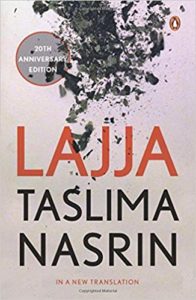Subtly chilling: Taslima Nasrin’s ‘Lajja’
‘Subtly chilling’ are the words that can describe Taslima Nasrin’s ‘Lajja’. Translated and published across 40 languages, Lajja was originally written in Bangla, the native language of Bangladesh. The book was banned within the few days of its release. Thereafter, Nasrin, a citizen of Bangladesh, had to eventually shift base. Published in 1993, recently the book completed its silver anniversary. Nasrin herself wrote a preface for the latest edition of the book.
The most striking aspect of Lajja is its constant relevance even after a quarter century of its release. Set against the aftermath of Babri Masjid demolition in 1992, Lajja speaks volumes in its short course. The mosque demolished by one community in one land has dangerous repercussions for the same community in another land. Nasrin, a Muslim, portrays her Hindu characters accurately against the backdrop of communal riots. Lajja, in its distorted narrative, covers a timespan from the partition of India and Pakistan to the contemporary period. Non- linear narrative of Lajja displays all the cruelties and atrocities bestowed upon Hindus, a minority in Muslim state- Bangladesh.
The story revolves around Sudhamoy and Suronjan- the father-son duo. Sudhamoy, who is at his old age, has witnessed a lot. He suffered when the liberation movement of 1971 was at rising and Bangladesh, at last, became a free nation after many tussles across nations. Suronjan, an unemployed youth, feels tired and hopeless for his country. Despite being bright and revolutionary in his approach towards society, Suronjan is defeated mentally and has turned into a pessimist.

A copy of Lajja
The women of the Hindu households are portrayed as weak, vulnerable and prone to harassment amidst the political tension and communal turmoil in Bangladesh. The book is filled with instances of Hindu women being raped and murdered. At this juncture, readers feel the palpable grief of the characters who have lost their homes, lands and even their identity. Hindus, in order to save their lives, convert or change their looks, so that they cannot be recognised. The trauma scars the generations ahead. No one in the book is untouched from political on-goings. It is like a giant wheel, which crushes everyone it comes in contact with through its course.
The intriguing part of Lajja is that it speaks for those who fail to speak for themselves because their circumstances do not allow them to do so. In the constant search for their identity in a land where their ancestors lived and where they are born, Hindu minorities live under the heap of fear, fatigue and pacified and unexpressed rage. Their lands are stolen, their worship places are defaced and their pride is thrown in the fissure caused by the Muslim in the ‘secular’ Bangladesh. Apparently, this rage, communal tension, divide and all the other atrocities are reflected in an inverted situation in India at that point of time- where Hindus are a majority and Muslims are a minority.
Nasrin was criticised by Muslim fundamental and orthodox forces. She was compelled to flee Bangladesh and live in exile. She elaborates on this in the preface that she wrote for the book. Its gruesome accounts and numbing reflections make Lajja- a chilling, hitting hard and sensitive read.
(Article submitted by Priya Gupta)
